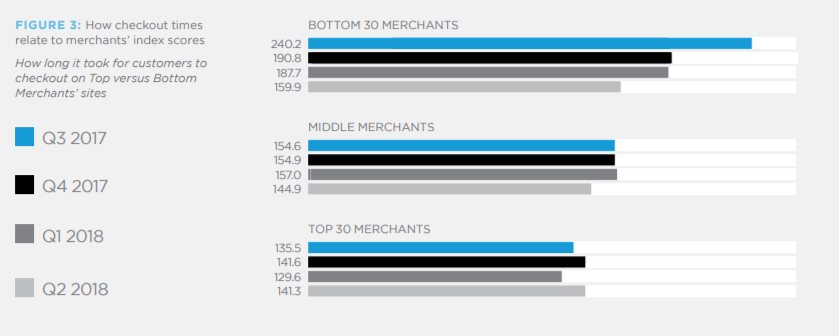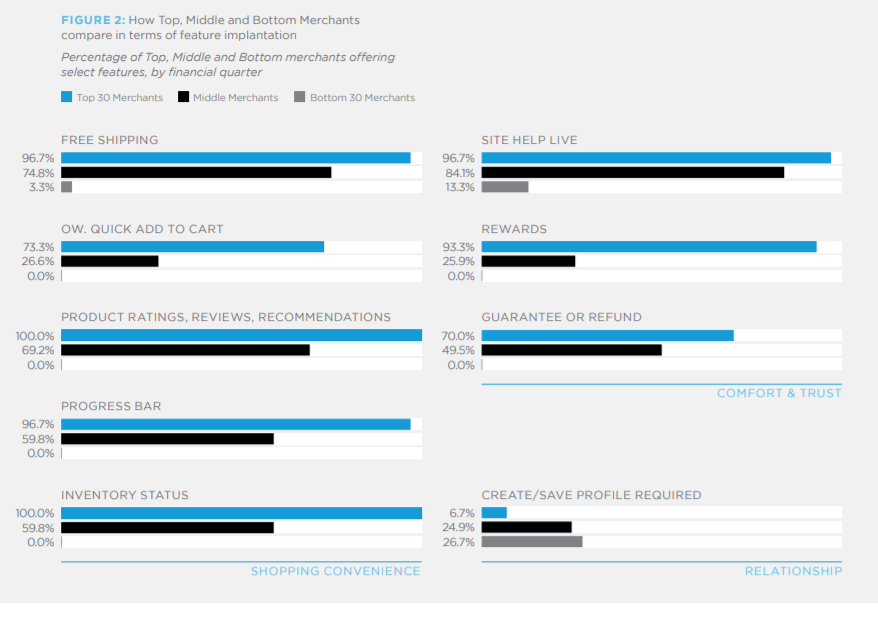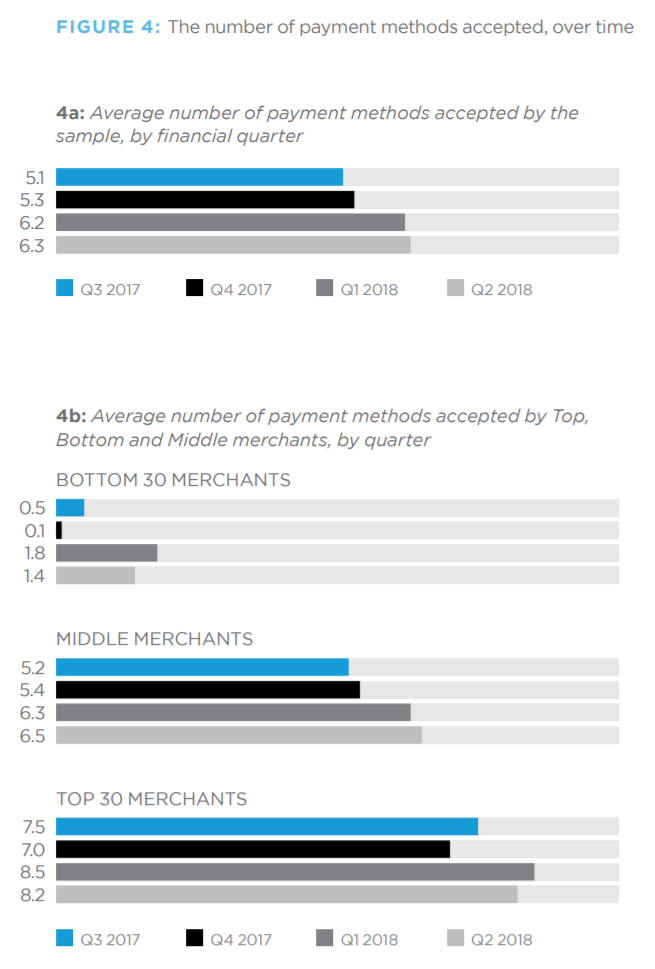The time it takes to complete mobile checkouts is decreasing, meaning ecommerce business must start pulling out all the stops to capitalize on the market.
Checkout Times are Decreasing
As mobile sites become more savvy and consumers gain confidence in transacting via their devices, the path that leads from the first touch to the end purchase is decreasing. According to a new Checkout Conversion Index (CCI) report published by PYMNTS.com, the average time it took for a mobile checkout to occur in Q2 of 2018 shortened by 12 seconds to a total of 2:25 minutes, compared to the previous quarter.

Image Source: PYMNTS.com
The report, which sampled 673 merchants in the United States that comprise of roughly 73% of ecommerce revenue in the United States, examined several important checkout elements that are available to offer on a mobile site, assessing a final score and then breaking down key comparisons between merchants who placed in the “Top 30” category, and those who placed in the “Bottom 30”.
Essential Features
14 key features considered to “make or break the checkout experience” were focused on in the report. Among those features, only one required users to create and save a user profile, which should be a stark reminder to ecommerce businesses that guest checkouts can go a very long way in generating more conversions.

Image Source: PYMNTS.com
Of the 14 features, it was determined that the highest performing merchants (those in the top 30) offered at least eight of them: free shipping, quick add to cart, product ratings and reviews, progress bar, inventory status, live site help, rewards, and guarantees and refunds.

Image Source: PYMNTS.com
Three of the eight key features were revealed to be growing at a very healthy pace: Live site help jumped from 67.1% in Q3 2017 to 81.5% in Q2 2018, with free shipping and product reviews showing similar signs of growth.
In terms of comparing top 30 merchants and bottom 30 merchants, there is a staggering difference when it comes to implementation of these features. As an example, 100% of the top 30 merchants offered features such as product reviews and inventory status, as opposed to the 0% of bottom 30 merchants that offered the same features.
Another valuable takeaway involved the number payment methods. In short, the more payment methods a merchant offered, the higher the probability that the merchant would be placed in the top 30 category. Among those high-performing merchants, it was determined that they offered an average of 8 different payment methods compared to the bottom 30 merchants which offered an average of 1.

Image Source: PYMNTS.com
Additional Insights
More general mobile metrics were also made available in the CCI report, which will give ecommerce businesses a lot to think about when it comes to further optimizing their mobile cart.
23% of people who own a smartphone in the United States use them for making purchases of some kind. As of last year, it was recorded that mobile commerce took up a 34.5% share of the US ecommerce market. That number is expected to grow significantly in the next three years, likely reaching 53.9%.
Another interesting insight drilled down on mobile app development. While the number of merchants who offer a mobile app has grown since Q4 2017, there was actually a decline from mobile apps built in Q2 2018 compared to Q1, which may suggest that the popularity revolving around mobile apps may have hit its peak. Conversely, Q2 2018 witnessed a record number of merchants who presented a fully-optimized mobile site.
Optimization Efforts
As 2019 quickly approaches, there’s no doubt that a continued effort on providing an optimized experience for mobile checkouts will be paramount for increasing mobile commerce revenue. There’s much to glean from the CCI findings, but there are a couple of points in particular that businesses will want to be mindful of.
Forcing customers to register for an account before having the ability to purchase should be avoided at all costs. Consumer expectations are rising, and with the amount of businesses currently offering a guest checkout process, we’re nearing a point where not having that option is becoming archaic practice.
Also feature-related, but if you’re strapped for resources and can’t focus on providing the eight essential elements listed above, at least try to offer competitive shipping (if you’re selling physical goods), provide a live chat feature (there are plenty of great tools available only that will integrate nicely with your website), and start to further leverage company and product reviews. Nearly 95% of shoppers read online reviews before making a purchase, and even if the reviews aren’t entirely positive, they’re giving users a stronger sense of authenticity and trust, so use that to your advantage.
The final area of focus is payment methods. Simply offering payments via credit card is not good enough anymore. Start to take advantage of alternative forms of payments like e-wallets, chatbots, and even crypto currencies. The more methods you offer, the wider the net you’re casting.
At the end of the day, mobile cart optimization will never be a perfect science, but the more features you can chip away, and the easier you make it for customers to avoid points of friction, the higher your chances of success.
